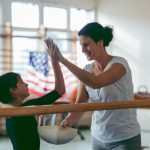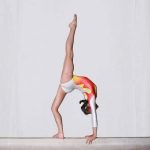A Headstand in gymnastics can be a tricky skill to learn, especially for beginner gymnasts. It can also lead to injuries if performed incorrectly, so for that reason, you should always learn how to Headstand in a safe environment with guidance from a professional.
In gymnastics, the Headstand is different from a Yoga Headstand as we balance with flat hands and not the elbows!
If you follow these tips, a proper gymnastics Headstand will become a skill you can master with enough practice.
Let’s get into this!
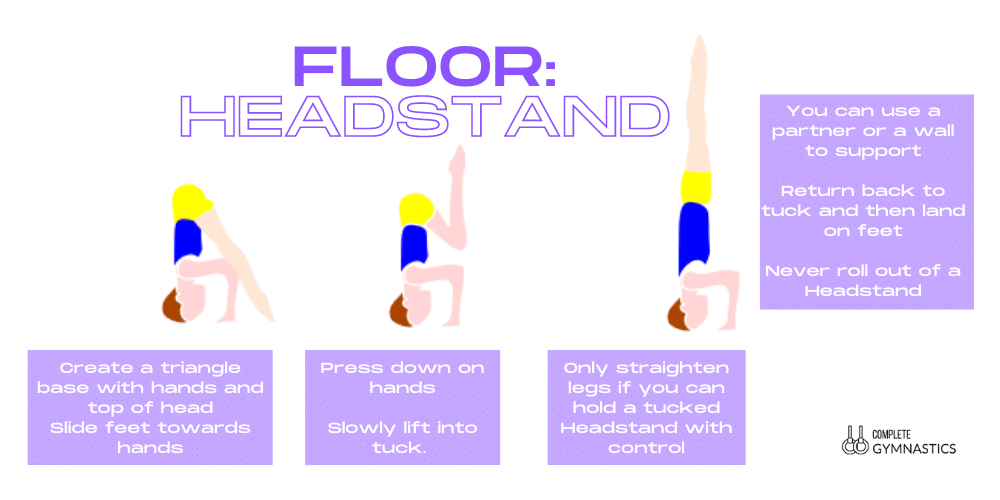
Disclaimer: Gymnastics carries an inherent level of risk. Information contained in this article does not replace the need for professional coaching in a recognized gymnastics facility.
#1 Start with Frog Balance
A Frog Balance is a great place to start as it is performed with bent elbows just like a Headstand. It also uses a lot of pressure on the hands and elbows which also replicates the technique of a Headstand.
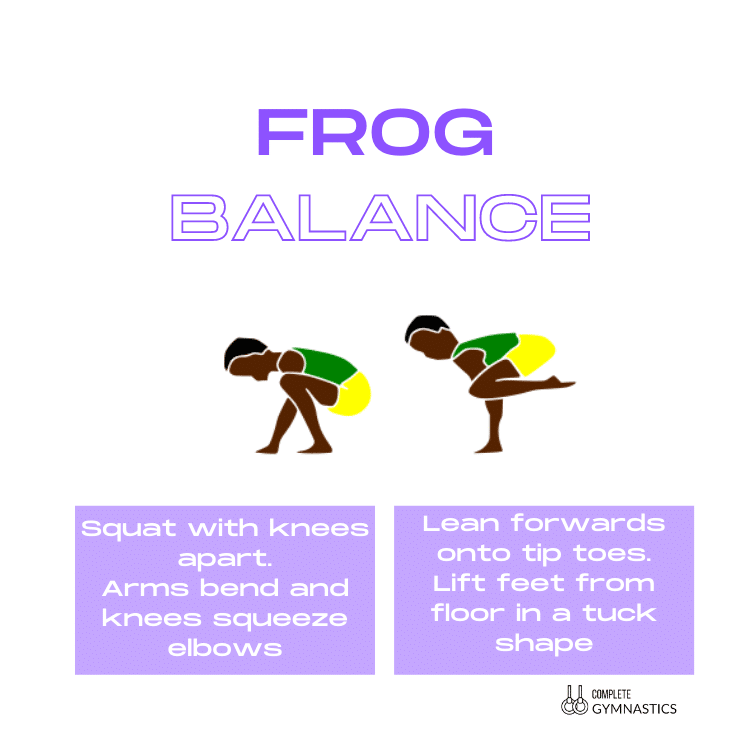
The knees are apart in a Frog Balance so they can rest on the bent elbows. The other big difference is that the head doesn’t touch the floor. For a beginner, this can help as it gives you time to get comfortable with going upside down.
#2 Use the Crown of your Head
The safest and most comfortable way to learn a Headstand is on the crown of your head. Some beginners will try to use their forehead which can cause a neck injury and will stop you from performing the Headstand correctly.
To check you know where the Crown is you can use your thumb and index finger from the top of the nose over the top of your head. This is the part of your head that is flatter.

#3 Triangle Base
The key to holding any balance, including Headstand, is creating a stable base. For Headstand the base is created using two hands and the head.
The head should be placed further forward than the hands to create a triangular base.
If the hands and head are all in a straight line the area of the base is greatly reduced and it becomes a lot harder to hold the balance when upside down.
The bigger the base, the better the balance.
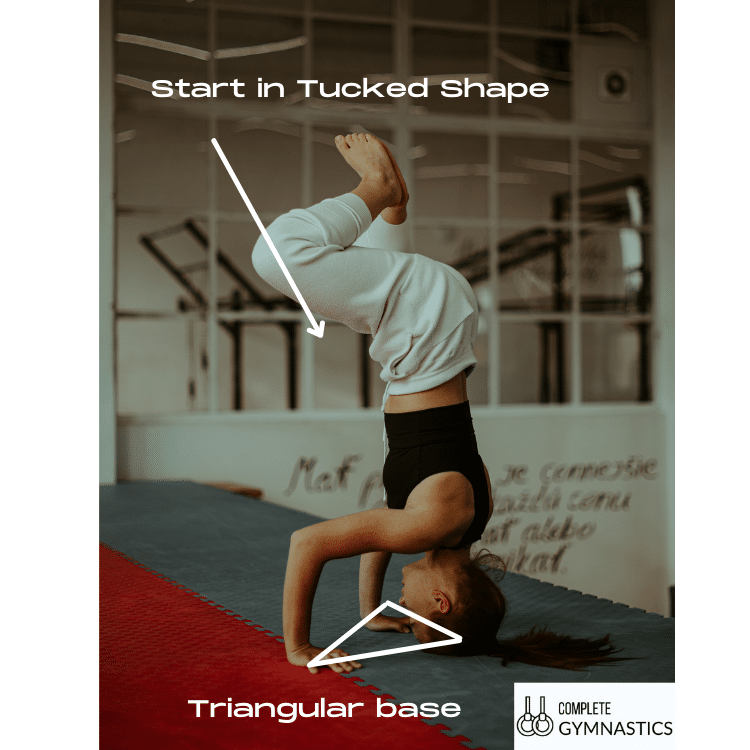
#4 Press down on hands
Once you have your triangular base, you also need to make sure you press down on your hands.
And I mean really press down!
Plenty of beginners underestimate how important the hands are in holding the balance. Press down with the whole hand, especially the fingertips as this will help grip the floor and increase stability. Try not to move your hands whilst in the Headstand as this will increase the weight on your head and could cause an injury.
It’s better to come down first and then adjust the hand position.
#5 Only Tuck shape first
By starting with a tucked Headstand in gymnastics you lower the center of gravity and make it easier to hold a Headstand. You begin the Headstand in exactly the same way but once upside down the knees stay bent and in the chest.
Only move onto straight-leg headstands once you’ve mastered this.
As soon as the legs straighten and extend up, the higher center of gravity will make you less stable so don’t rush this step.
#6 Use a thin mat
A thin mat like a panel mat or yoga mat is ideal for practicing Headstands as they are both protective and stable.
If you use a thicker, squishier landing mat or inflatable mat the head and hands will sink into the mat more and cause you to wobble.
Cheap panel mats are easily available on Amazon, like the Antsy Pantsy Tumble Mat pictured, which is ideal for learning a Headstand.

#7 Use a wall or a partner
Rolling forwards out of a Headstand is dangerous for your neck so to avoid this happening use a wall or a partner. This way your legs cannot go forward over the top of your head. You will need to place your head close to the wall and have your hands set back to create the triangle base. Once you are upside down, your back should mostly be contacting the wall.
If you don’t have a suitable wall space you can use a partner to support you instead. Have your partner sit in a straddle shape on the floor and they will support you around the waist as you go upside down. This is slightly harder than a wall so make sure you have a partner that is strong enough to support you properly.
#8 Land on Feet
At the end of the Headstand, always return to your feet for landing. This shows good control, will reduce the chances of injury and it looks a lot better as well.
I often see beginner gymnasts collapse or roll onto the floor at the end of the Headstand and it’s just not good technique.
#9 Improve your core strength
If a beginner gymnast is struggling with Headstands even after following the other tips in this article, it’s usually the core strength that needs improving. Sure, you need a bit of upper body strength but it’s mainly the core muscles that are creating stability when you’re in the Headstand position. So if you feel like you’re getting up into the Headstand but are falling straight down, work on core strengthening.
This should include basics like sit-ups and v-ups but also include hollow dish holds, arch holds and planks. If you have a gymnastics bar at home then you should be including leg lifts as part of a core workout.
Final Thoughts
Some beginners manage to master it straight away but don’t get disheartened if you need a while longer to learn a Headstand. Gymnastics is all about practicing and repeating lots and lots so just stick with it!
You should only practice it for a limited amount of time each lesson as the neck and back will start to ache after a lot of repetitions.
FAQs
Can a beginner learn a Headstand?
A beginner can learn a Headstand with the correct guidance and support. You should always warm up properly beforehand and I would encourage a beginner to be familiar with basic gymnastic shapes before they move onto skills like Headstand. Although Headstand is thought of as a basic gymnastics skill, a beginner probably wouldn’t learn it straight away.
How long does it take to learn a Headstand?
Everybody is different and learns at different speeds so it is impossible to put an exact time on how long it takes to learn a Headstand. In my experience, an average beginner aged 7 to 10 years old should be able to learn a Headstand within 6 to 10 lessons.
What is the difference between a handstand and a headstand in gymnastics?
In a Headstand the head touches the floor whereas in a Handstand only the hands touch the floor. Headstands are easier for most gymnasts as they have a bigger area of support.
Who should not do a headstand?
People with existing health conditions should avoid doing headstands. Likewise, pregnant women should not attempt headstands. If you are unsure always consult a medical professional.
- How to Do a Back Handspring: Complete Step-by-Step GuideLearning how to do a back handspring is an exciting milestone for any gymnast. It builds confidence, agility, and forms the foundation for advanced tumbling… Read more: How to Do a Back Handspring: Complete Step-by-Step Guide
- How To Get Over a Mental Block In Gymnastics: A Complete GuideGymnastics is a sport that requires not only physical strength and skill but also mental strength. When a gymnast feels like they cannot attempt a… Read more: How To Get Over a Mental Block In Gymnastics: A Complete Guide
- The Best Leotard for Girls in 2025: What to Look ForFinding an ideal leotard for girls isn’t just about picking a dazzling design that sparkles (although it does help!). The leotard has to fit perfectly,… Read more: The Best Leotard for Girls in 2025: What to Look For
- The Best Gymnastics Shorts (Our Top Picks)The best gymnastics shorts are designed to be worn over the top of a leotard providing additional coverage around the upper legs, whilst allowing gymnasts… Read more: The Best Gymnastics Shorts (Our Top Picks)
- Decathlon Leotards – Are They Any Good?If you’re in the market for a new leotard, you may be wondering if Decathlon leotards are any good considering the low cost of their… Read more: Decathlon Leotards – Are They Any Good?
- A Complete Guide to Gymnastics Hand RipsAre you tired of dealing with painful gymnastics rips on your hands from training? Look no further – this article offers a comprehensive approach to… Read more: A Complete Guide to Gymnastics Hand Rips
